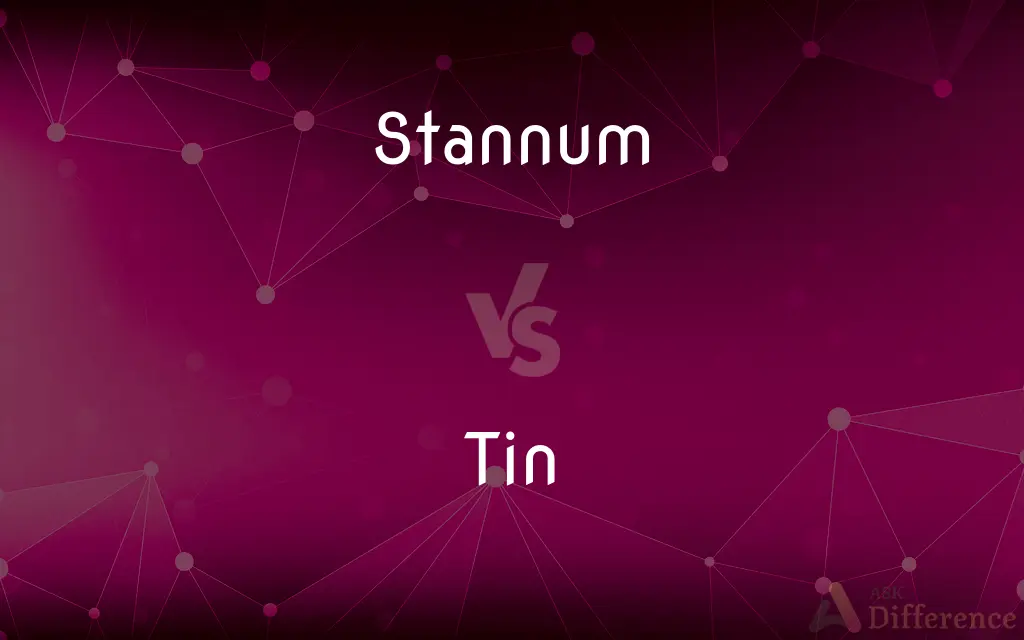Stannum vs. Tin — What's the Difference?
By Tayyaba Rehman & Maham Liaqat — Updated on April 6, 2024
Stannum is the Latin name for tin, primarily used in scientific contexts, whereas tin is the common name for the same chemical element, widely used in everyday language.

Difference Between Stannum and Tin
Table of Contents
ADVERTISEMENT
Key Differences
Stannum, known by its symbol Sn, is the Latin term for the chemical element tin. It's often seen in scientific and academic discussions. On the other hand, tin is the English name for the same element, more commonly used in everyday language and industry contexts.
Tin has been used historically for a variety of applications, such as in bronze manufacturing and as a protective coating for other metals. Whereas stannum, as a term, is not typically used outside of formal or scientific descriptions, emphasizing the historical and practical importance of tin in human culture.
In the periodic table, tin (Sn) is recognized for its malleability, low melting point, and resistance to corrosion. Stannum, while referring to the same element, is associated more with the element’s academic and theoretical aspects, including its atomic number 50 and its place in group 14 of the periodic table.
The usage of tin in everyday language reflects its widespread applications in solder, pewter, and tin plating. Conversely, stannum might be mentioned in scholarly articles, scientific studies, and historical contexts, pointing out its dual identity in the realm of chemistry.
Despite the different contexts in which they are used, both terms refer to the same element essential to modern technology and industry. Tin symbolizes its practical application and common recognition, while stannum represents its scientific identity and historical nomenclature.
ADVERTISEMENT
Comparison Chart
Terminology Origin
Latin
English
Usage Context
Scientific and academic
Everyday language and industry
Symbol in Chemistry
Sn
Sn
Historical Usage
Rare, mainly in scientific literature
Common, used since ancient times
Application
Referenced in academic discussions
Used in products like metals and alloys
Compare with Definitions
Stannum
Latin term for tin, used in scientific contexts.
The periodic table lists stannum as the Latin equivalent of tin.
Tin
A soft, malleable metal with a low melting point and high corrosion resistance.
Tin is often used to make solder for electronics.
Stannum
A chemical element with the symbol Sn and atomic number 50.
Stannum is a post-transition metal in group 14 of the periodic table.
Tin
Commonly used in alloys and as a protective coating.
Pewter, an alloy of tin, has been used for centuries in tableware.
Stannum
Symbolic of the element's historical nomenclature.
Alchemists referred to this metal as stannum in ancient texts.
Tin
The common name for the element with symbol Sn.
Tin is an essential component in the manufacturing of bronze.
Stannum
Associated with academic and theoretical discussions.
Stannum's properties were thoroughly discussed in the research paper.
Tin
Widely recognized in various industries.
The tin plating process protects steel from corrosion.
Stannum
Rarely used in everyday language.
In his lecture on metals, the professor referred to tin as stannum.
Tin
Part of everyday language and practical applications.
Tin cans are a common form of food packaging.
Stannum
Tin
Tin
Tin is a chemical element with the symbol Sn (from Latin: stannum) and atomic number 50. Tin is a silvery metal that characteristically has a faint yellow hue.
Stannum
The technical name of tin. See Tin.
Tin
Symbol Sn A crystalline, silvery metallic element obtained chiefly from cassiterite, and having two notable allotropic forms. Malleable white tin is the useful allotrope, but at temperatures below 13.2°C it slowly converts to the brittle gray allotrope. Tin is used to coat other metals to prevent corrosion and is a part of numerous alloys, such as soft solder, pewter, type metal, and bronze. Atomic number 50; atomic weight 118.71; melting point 231.93°C; boiling point 2,602°C; specific gravity (gray) 5.77, (white) 7.29; valence 2, 4. See Periodic Table.
Tin
Tin plate.
Tin
A container or box made of tin plate.
Tin
A container for preserved foodstuffs; a can.
Tin
The contents of such a container.
Tin
To plate or coat with tin.
Tin
Chiefly British To preserve or pack in tins; can.
Tin
Of, relating to, or made of tin.
Tin
Constructed of inferior material.
Tin
Spurious.
Tin
(uncountable) A malleable, ductile, metallic element, resistant to corrosion, with atomic number 50 and symbol Sn.
Tin
An airtight container, made of tin or another metal, used to preserve food, or hold a liquid or some other product.
A tin of baked beans; a tobacco tin; a tin of shoe polish
Empty tins, cans, and plastic containers are recycled in the blue bins.
Tin
(countable) A metal pan used for baking, roasting, etc.
Muffin tin
Roasting tin
Baking tin
Tin
The bottom part of the front wall, which is "out" if a player strikes it with the ball.
Tin
Money, especially silver money.
Tin
Computer hardware.
Tin
Made of tin.
Tin
Made of galvanised iron or built of corrugated iron.
Tin
(transitive) To place into a metal can (ie. a tin; be it tin, steel, aluminum) in order to preserve.
Tin
(transitive) To cover with tin.
Tin
(transitive) To coat with solder
Tin
To coat with solder, in preparation for soldering, to ensure a good solder joint
Tin
To coat with solder, in order to consolidate braided wire, so as to make contact with all strands and reduce fragility of the fraying wire
Tin
Thin plates of iron covered with tin; tin plate.
Tin
Money.
Tin
To cover with tin or tinned iron, or to overlay with tin foil.
Tin
A silvery malleable metallic element that resists corrosion; used in many alloys and to coat other metals to prevent corrosion; obtained chiefly from cassiterite where it occurs as tin oxide
Tin
Metal container for storing dry foods such as tea or flour
Tin
Airtight sealed metal container for food or drink or paint etc.
Tin
Plate with tin
Tin
Preserve in a can or tin;
Tinned foods are not very tasty
Tin
Prepare (a metal) for soldering or brazing by applying a thin layer of solder to the surface
Common Curiosities
Are stannum and tin the same thing?
Yes, stannum and tin refer to the same chemical element, symbolized as Sn in the periodic table.
What is stannum?
Stannum is the Latin name for the chemical element tin, primarily used in scientific contexts.
What is tin used for?
Tin is used in solder, alloys like pewter and bronze, and as a protective coating for other metals.
What is the atomic number of tin?
The atomic number of tin (stannum) is 50.
Is tin magnetic?
Tin is not magnetic; it is a non-magnetic metal.
What are common uses of tin today?
Common uses include soldering, in alloys, and for tin plating to prevent corrosion.
Why do scientists use the term stannum?
Scientists use stannum for its historical and standardized nomenclature in scientific discussions.
How is tin extracted?
Tin is extracted through mining and refining of cassiterite into pure tin metal.
Where is tin found?
Tin is obtained mainly from the mineral cassiterite, where it is found as tin dioxide.
What is the difference between tin and aluminum?
Tin and aluminum are different elements with distinct properties; aluminum is lighter and has a higher melting point than tin.
Why is tin called stannum in Latin?
The name stannum comes from ancient Latin, reflecting the historical usage and nomenclature of the element.
Can tin rust?
Tin is corrosion-resistant and does not rust in the same way iron does, making it valuable for protective coatings.
Why is tin important?
Tin is important for its uses in alloys, electronics, and corrosion-resistant coatings, playing a crucial role in various industries.
How was tin discovered?
Tin has been known since ancient times, used in alloys like bronze; its discovery predates written history.
Is tin safe to eat off?
Yes, tin is considered safe and is used in food packaging and coatings for culinary utensils.
Share Your Discovery

Previous Comparison
Noob vs. Newb
Next Comparison
Tool vs. ResourceAuthor Spotlight
Written by
Tayyaba RehmanTayyaba Rehman is a distinguished writer, currently serving as a primary contributor to askdifference.com. As a researcher in semantics and etymology, Tayyaba's passion for the complexity of languages and their distinctions has found a perfect home on the platform. Tayyaba delves into the intricacies of language, distinguishing between commonly confused words and phrases, thereby providing clarity for readers worldwide.
Co-written by
Maham Liaqat













































